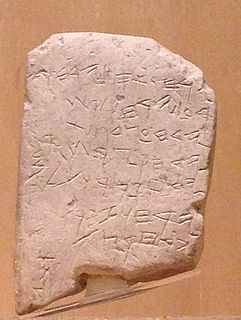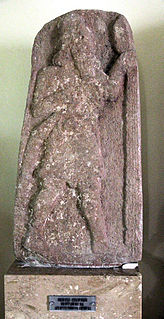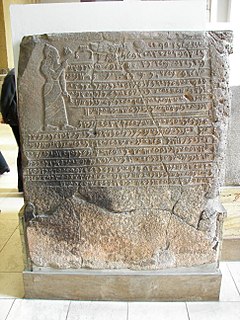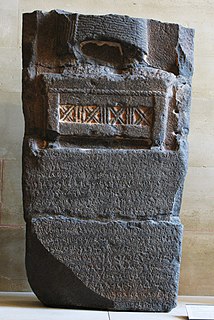 W
WA stele, or occasionally stela, when derived from Latin, is a stone or wooden slab, generally taller than it is wide, erected in the ancient world as a monument. The surface of the stele often has text, ornamentation, or both. These may be inscribed, carved in relief, or painted.
 W
WBaal with Thunderbolt or the Baal stele is a white limestone bas-relief stele from the ancient kingdom of Ugarit in northwestern Syria. The stele was discovered in 1932, about 20 metres (66 ft) from the Temple of Baal in the acropolis of Ugarit, during excavations directed by French archaeologist Claude F. A. Schaeffer. The stele depicts Baal, the Aramean god of storm and rain, and is considered the most important of the Ugaritic stelae. The stele is on display at the Musée du Louvre in Paris.
 W
WThe Code of Hammurabi is a Babylonian legal text composed c. 1755–1750 BC. It is the longest, best-organised, and best-preserved legal text from the ancient Near East. It is written in the Old Babylonian dialect of Akkadian, purportedly by Hammurabi, sixth king of the First Dynasty of Babylon. The primary copy of the text is inscribed on a basalt stele 2.25 m tall. The stele was discovered in 1901, at the site of Susa in present-day Iran, where it had been taken as plunder six hundred years after its creation. The text itself was copied and studied by Mesopotamian scribes for over a millennium. The stele now resides in the Louvre Museum.
 W
WThe Daskyleion steles are three marble steles discovered in 1958 in Dascylium, in northwest Turkey.
 W
WThe Deir 'Alla Inscription, known as KAI 312, was discovered during a 1967 excavation in Deir 'Alla, Jordan. It is currently at the Jordan Archaeological Museum.
 W
WThe Ekron Royal Dedicatory Inscription, or simply the Ekron inscription, is a royal dedication inscription found in its primary context in the ruins of a temple during the 1996 excavations of Ekron. It is known as KAI 286.
 W
WThe El-Kerak Inscription was discovered in 1958 in Jordan, near the El-Kerak wadi. It is a basalt inscription fragment measuring 12.5 centimeters (4.9 in) high by 14 centimeters (5.5 in) wide. The inscription has been dated to the late ninth century BC. The inscription is known as KAI 306.
 W
WThe Eshmunazar II sarcophagus is a 6th-century B.C. sarcophagus unearthed in 1855 in the "Phoenician Necropolis", a hypogeum in the southern area of the city of Sidon in modern-day Lebanon. The sarcophagus was discovered by members of the French consulate in Sidon and was donated to the Louvre. The Eshmunazar II sarcophagus has two sets of Phoenician inscriptions, one on its lid and the other on its trough, under the sarcophagus head. The lid inscription was of great significance upon its discovery; it was the first Phoenician language inscription to be discovered in Phoenicia proper, the most detailed Phoenician inscription ever found anywhere up to that point, and is the second longest extant Phoenician inscription after the Karatepe bilingual inscription.
 W
WThe Gezer calendar is a small limestone tablet with an early Canaanite inscription discovered in 1908 by Irish archaeologist R. A. Stewart Macalister in the ancient city of Gezer, 20 miles west of Jerusalem. It is commonly dated to the 10th century BCE, although the excavation was unstratified and its identification during the excavations was not in a "secure archaeological context", presenting uncertainty around the dating.
 W
WThe "Hadad Statue" is an 8th-century BC stele of King Panamuwa I, from the Kingdom of Ya'diya in Sam'al. It is currently occupies a prominent position in the Vorderasiatisches Museum Berlin.
 W
WThe Kelashin Stele found in Kelashin, Iraq, bears an important Urartian-Assyrian bilingual text dating to c. 800 BC, first described by Friedrich Eduard Schulz in 1827. Part of Schulz's notes were lost when he was killed by Kurdish "bandits", and later expeditions were either prevented by weather conditions or Kurdish brigands, so that a copy of the inscription could only be made in 1951 by G. Cameron, and again in 1976 by an Italian party under heavy military protection.
 W
WThe Keşlik Stele is a Neo-Hittite monument from northern Tyana, near Niğde discovered in 1962 in southern Turkey, which dates from the 8th century BC.
 W
WThe Kilamuwa Stele is a 9th-century BC stele of King Kilamuwa, from the Kingdom of Ya'diya. He claims to have succeeded where his ancestors had failed, in providing for his kingdom. The inscription is known as KAI 24.
 W
WThe Kurkh Monoliths are two Assyrian stelae that contain a description of the reigns of Ashurnasirpal II and his son Shalmaneser III. The Monoliths were discovered in 1861 by a British archaeologist John George Taylor, who was the British Consul-General stationed in the Ottoman Eyalet of Kurdistan, in a town called Kurkh, which is now known as Üçtepe, in the district of Bismil, in the province of Diyarbakir of Turkey. Both stelae were donated by Taylor to the British Museum in 1863.
 W
WThe Kuttamuwa stele is an 800-pound basalt funerary stele with an Aramaic inscription referring to Kuttamuwa, an 8th-century BC royal official. It was found in Sam'al, in southeastern Turkey, in 2008, by the Neubauer Expedition of the Oriental Institute at the University of Chicago.
 W
WThe Manishtushu Obelisk is a diorite, four-sided stele. The stele is obelisk-shaped, as well as it narrows upward to its (damaged) top, in a pyramidal-form. The obelisk was erected by Manishtushu, son of Sargon the Great, of the Akkadian Empire, who ruled circa 2270–2255 BC.
 W
WNarundi was a goddess of the city of Susa in Elam. A statue of her is located in the Louvre Museum, where she appears seated on a lion throne, holding a cup and the branch of a palm tree in her hand. She is quite similar to the Sumerian goddess Inanna, and the style of the sculpture itself is reminiscent of Mesopotamian art.
 W
WThe Neirab steles are two 8th-century BC steles with Aramaic inscriptions found in 1891 in Al-Nayrab near Aleppo, Syria. They are currently in the Louvre. They were discovered in 1891 and acquired by Charles Simon Clermont-Ganneau for the Louvre on behalf of the Commission of the Corpus Inscriptionum Semiticarum. The steles are made of black basalt, and the inscriptions note that they were funerary steles.
 W
WThe ‘’’Panamuwa II inscription’’’ is a 9th-century BC stele of King Panamuwa II, from the Kingdom of Ya'diya in Sam'al. It is currently occupies a prominent position in the Vorderasiatisches Museum Berlin.
 W
WThe Statue of Idrimi is an important ancient Middle Eastern sculpture found at the site of Alalakh by the British archaeologist Sir Leonard Woolley in the 1930s. Dating from the 16th century BC, the statue is famous for its long biographical inscription of King Idrimi written in the Akkadian language. It has been part of the British Museum's collection since 1939. The inscription includes the "first certain cuneiform reference" to Canaan.
 W
WThe commemorative stelae of Nahr el-Kalb are a group of over 20 inscriptions and rock reliefs carved into the limestone rocks around the estuary of the Nahr al-Kalb in Lebanon, just north of Beirut.
 W
WAn undeciphered alphabetic stele found in Ördek-Burnu, 20 km south of Sam'al in what is now northern Syria, dates to the 9th century BCE. The language of the inscription is difficult to interpret. It contains Semitic words but is not grammatically Semitic, and may be a mixture of Luwian and a Semitic language. It is kept in Istanbul.
 W
WThe Stele of the Vultures is a monument from the Early Dynastic III period in Mesopotamia celebrating a victory of the city-state of Lagash over its neighbour Umma. It shows various battle and religious scenes and is named after the vultures that can be seen in one of these scenes. The stele was originally carved out of a single slab of limestone, but only seven fragments are known today. The fragments were found at Tello in southern Iraq in the late 19th century and are now on display in the Louvre. The stele was erected as a monument to the victory of king Eannatum of Lagash over Ush, king of Umma.
 W
WThe Tel Dan Stele is a fragmentary stele containing a Canaanite inscription, discovered in 1993 in Tel-Dan by Gila Cook, a member of an archaeological team lead by Avraham Biran, the pieces having been used to construct an ancient stone wall that survived into modern times. The stele is in several pieces and contains several lines of Aramaic, closely related to Hebrew and historically a common language among Jews. The surviving inscription, which dates to 9th century BCE, details that an individual killed Jehoram, the son of Ahab, king of Israel and the king of the house of David. These writings corroborate passages from the Bible, as the Second Book of Kings mentions that Jehoram, also Joram, is the son of an Israelite king, Ahab, by his Phoenician wife, Jezebel. Applying a Biblical viewpoint to the inscription, the likely candidate for having erected the stele is Hazael, an Aramean king, whose language would have been Aramaic, who is mentioned in Second Book of Kings as having conquered the Land of Israel, though he was unable to take Jerusalem. The stele is currently on display at the Israel Museum, and is known as KAI 310.
 W
WThe Trumpeting Place inscription is an inscribed stone from the 1st century CE discovered in 1968 by Benjamin Mazar in his early excavations of the southern wall of the Temple Mount. The stone, showing just two complete words written in the Square Hebrew alphabet, was carved above a wide depression cut into the inner face of the stone. The first word is translated as "to the place" and the second word "of trumpeting" or "of blasting" or "of blowing", giving the phrase "To the Trumpeting Place". The subsequent words of the inscription are cut off. The third word (...לה), which is incomplete, has been interpreted as either "declare" or "distinguish", giving either: "to d[eclare ]" or "to d[istinguish ]", where the words in square brackets represent scholarly conjecture.
 W
WThe Victory stele of Esarhaddon is a dolerite stele commemorating the return of Esarhaddon after his army's 2nd battle and victory over Pharaoh Taharqa in northern ancient Egypt in 671 BC. It was discovered in 1888 in Zincirli Höyük by Felix von Luschan and Robert Koldewey. It is now in the Pergamon Museum in Berlin.
 W
WThe Victory Stele of Naram-Sin is a stele that dates to approximately 2254-2218 BC, in the time of the Akkadian Empire, and is now in the Louvre in Paris. The relief measures six feet in height and was carved in pink limestone. It depicts the King Naram-Sin of Akkad leading the Akkadian army to victory over the Lullubi, a mountain people from the Zagros Mountains. It shows a narrative of the King crossing the steep slopes into enemy territory; on the left are the ordered imperial forces keeping in rank while marching over the disordered defenders that lie broken and defeated. Naram-Sin in shown as by far the most important figure; he is shown towering over his enemy and troops and all eyes gaze up toward him. The weak and chaotic opposing forces are shown being thrown from atop the mountainside, impaled by spears, fleeing and begging Naram-Sin for mercy as well as being trampled underfoot by Naram-Sin himself. This is supposed to convey their uncivilized and barbaric nature making the conquest justified.
 W
WThe Xanthian Obelisk, also known as the Xanthos or Xanthus Stele, the Xanthos or Xanthus Bilingual, the Inscribed Pillar of Xanthos or Xanthus, the Harpagus Stele, the Pillar of Kherei and the Columna Xanthiaca, is a stele bearing an inscription currently believed to be trilingual, found on the acropolis of the ancient Lycian city of Xanthos, or Xanthus, near the modern town of Kınık in southern Turkey. It was created when Lycia was part of the Persian Achaemenid Empire, and dates in all likelihood to ca. 400 BC. The pillar is seemingly a funerary marker of a dynastic satrap of Achaemenid Lycia. The dynast in question is mentioned of the stele, but his name had been mostly defaced in the several places where he is mentioned: he could be Kherei (Xerei) or more probably his predecessor Kheriga.
 W
WThe Melqart stele, also known as the Ben-Hadad or Bir-Hadad stele is an Aramaic stele which was created during the 9th century BCE and was discovered in 1939 in Syria. The Old Aramaic inscription is known as KAI 201; its five lines reads:“The stele which Bir-Hadad, son of ‘Ezer, the Damascene, son of the king of Aram, erected to his Lord Melqart, to whom he made a vow and who heard his voice.”
 W
WThe Stele of Zakkur is a royal stele of King Zakkur of Hamath and Luhuti in the province Nuhašše of Syria, who ruled around 785 BC.